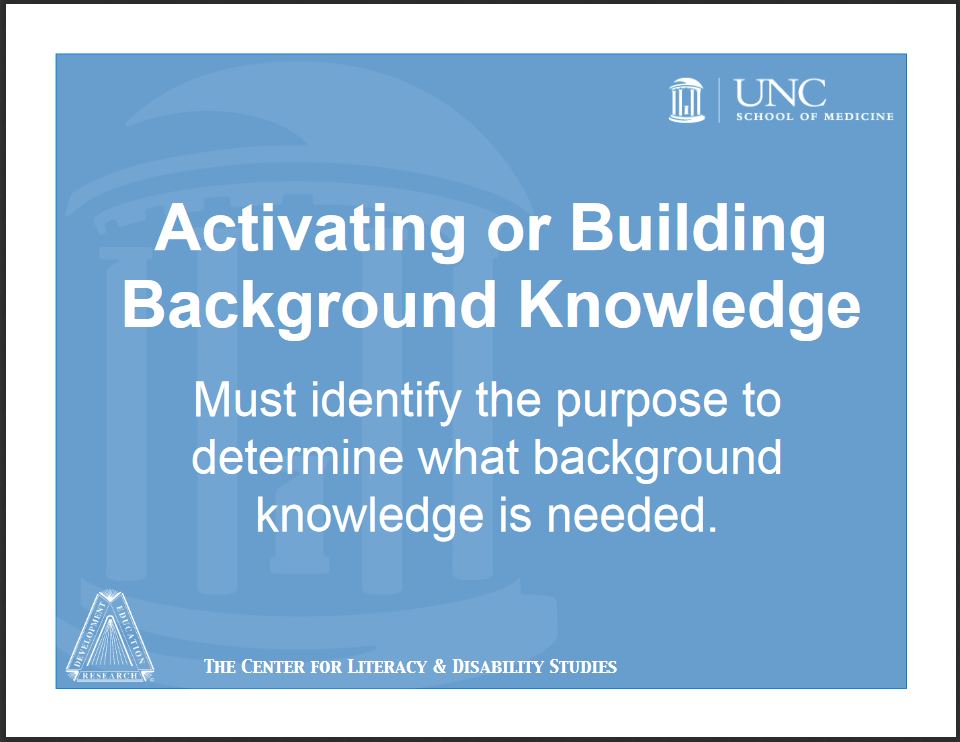“Text comprehension is a complex activity that can be overwhelming for students with significant cognitive disabilities.
It is critical that we teach students how to comprehend text whether they are reading independently or listening.
We can’t just test comprehension; we must teach it.”
–The Center for Literacy and Disability Studies
GUIDED READING
What is guided reading?
Guided reading is an evidence-based instructional approach that teaches students how to comprehend text. A main difference between shared vs. guided reading is that during shared reading, interactions are maximized. During guided reading, thinking is maximized.
During guided reading students actively participate in the group reading process – by listening or reading – and making their own conclusions about the text.
Text comprehension is a complex activity that presents challenges to learners of all types, but it can be overwhelming for students with significant cognitive disabilities.
Both reading and listening comprehension are forms of text comprehension. Both require students to understand the words, process them, remember them and construct meaning across the entire text. Reading comprehension is different from listening comprehension in that it ALSO requires students to decode or identify the words.
Which students would benefit from guided reading?
- are interested and engaged during shared reading interactions
- know most of the letters (name or sound) most of the time
- understand that print has meaning and
- have a means of communication and use it to initiate exchanges and interact with others.
How can students benefit from guided reading?

- help students understand that reading involves thinking and meaning making
- help students develop the skills and understandings necessary to be strategic in reading a wide variety of texts
- provide experience in a wide variety of text types
- increase student ability to self-select and apply purposes for comprehending
- develop comprehension of text and maximizing thinking
- build confidence as readers
How can we teach guided reading?
There are different ways to teach guided reading (e.g. Picture Walks, Directed Reading-Thinking Activity (DR-TA), K-W-L (what do I Know, what do I want to Know, what have I Learned), and Anchor-Read-Apply). The strategy Anchor-Read-Apply is explained below.
Anchor-Read-Apply is an instructional approach that supports students in learning how to activate background knowledge based on prior experience or build new background knowledge that they can connect to information contained in or related to the text. Because it emphasizes teaching students to activate or use existing background knowledge or ways of thinking, it is a strategy that promotes independent text comprehension from the very beginning.
Each component of the Anchor-Read-Apply lesson is critical to improving text comprehension. Comprehension requires the reader to know how to draw upon their existing knowledge, skills, and experiences to construct understandings from text. Having a clearly stated purpose focuses the reader on the most important information during instruction. The purpose needs to be broad enough to motivate processing of the entire text. Completing a clearly linked task helps readers apply what they have learned so that they can get informative feedback that will further increase their independence and success the next time they are trying to comprehend a text.
An important part of guided reading is the repeated reading of a text, every day for a week, reading for a different purpose each time. The purposes are set by the teacher and need to be broad to encourage the students to listen to the whole book.
(from Dynamic Learning Maps (DLM) – Teaching Text Comprehension: Anchor-Read-Apply)










Slides from ASHA 2015
Shared vs. Guided Reading


Resources for guided reading:
Where can I learn more?
Dynamic Learning Maps (DLM) – Teaching Text Comprehension: Anchor-Read-Apply
Participants will learn to identify the components of an Anchor-Read-Apply text comprehension lesson, match purposes for reading with anchor activities, and describe the difference between asking question to assess comprehension and teaching students to understand text in increasingly complex ways.
Online Self-directed Module
Facilitated Module Materials for Groups
Dynamic Learning Maps (DLM) – Generating Purposes for Reading
This module reviews the Anchor-Read-Apply framework for reading comprehension. Participants will learn how to generate purposes for reading using the DLM Essential Elements and review activities to help students activate background knowledge.
Online Self-directed Module
Facilitated Module Materials for Groups
Dynamic Learning Maps (DLM) – DR-TA and Other Text Comprehension Approaches
Participants will briefly review the anchor-read-apply framework and will be introduced to the DR- TA, KWL, and Yes/No comprehension instructional strategies.
Online Self-directed Module
Facilitated Module Materials for Groups